Exploring the Spatial and Temporal Correlation Between Habitat Quality and Habitat Fragmentation in the West Qinling Mountains, China
Abstract
:1. Introduction
2. Materials and Methods
2.1. Study Area
2.2. Data Sources
2.3. Methods
2.3.1. InVEST Model
2.3.2. Spatial Autocorrelation Analysis Methods
2.3.3. Habitat Fragmentation Index Selection
2.3.4. Construction of Integrated Habitat Fragmentation Index Assessment Model
2.3.5. GWR Model
3. Results
3.1. Determination of Appropriate Scale
3.2. Characterization of Spatial and Temporal Patterns of HQ
3.2.1. Spatial and Temporal Variation in HQ
3.2.2. Spatial Aggregation of HQ
3.3. Spatial and Temporal Characterization of CHFI
3.4. Spatial and Temporal Correlation Between HQ and CHFI
4. Discussion
4.1. Scaling Effects and Changing Trends of HQ
4.2. Relationship Between HQ and Response to Habitat Fragmentation
4.3. Innovations and Shortcomings
5. Conclusions
- (1)
- The 3 km grid scale was a suitable scale for the evaluation and analysis of HQ in the West Qinling Mountains. There was consistency in the temporal expression of scale effects by year differences, and variability in the spatial expression of HQ by grid size. And the 3 km grid scale was a turning point in the stabilization of mean HQ and in the change in area of each grade.
- (2)
- From 2000 to 2020, HQ of the West Qinling Mountains was at a higher level. From the analysis of temporal changes, the HQ showed a decreasing trend from 2000 to 2020. From the analysis of grade change, medium grade and higher grade were predominant, with a clear phenomenon of bipolar sharpening. From the analysis of spatial distribution, the HQ showed a distribution pattern of “high in the west and low in the east, low in the north and high in the south”. This distribution pattern showed a significant spatial positive correlation in space, which showed obvious spatial double clustering characteristics.
- (3)
- From 2000 to 2020, the habitat fragmentation of the West Qinling Mountains was at a medium level. From the analysis of temporal changes, CHFI showed an increasing trend from 2000 to 2020. From the analysis of grade change, the medium-fragmentation area increased, and the low-fragmentation area, the lower-fragmentation area, and the higher-fragmentation area all decreased, which demonstrated a clear bipolar contraction state. From the analysis of spatial distribution, CHFI showed a distribution pattern of “high in the east and low in the west, high in the north and low in the south”, and the overall spatial distribution of CHFI was retained with the change in time scale.
- (4)
- The effects of habitat fragmentation on HQ in the West Qinling Mountains showed a significant spatial and temporal non-stationary relationship, with a predominantly negative correlation. Negative correlation areas were mainly located in the Loess Plateau region of the north and the Qinling Mountains of the east, while positive correlation areas were mainly located in the Qinghai–Tibet Plateau region in the northwest and the Sichuan Basin region of the southwest. As the time scale changes, the degree and range of negative impacts increases and the area of change concentrates in the east-central part of the West Qinling Mountains. The study results suggest that the staggered distribution of forest, unused land, and water might counteract the negative impacts of unused land on HQ.
Author Contributions
Funding
Institutional Review Board Statement
Informed Consent Statement
Data Availability Statement
Conflicts of Interest
Abbreviations
| HQ | Habitat quality |
| InVEST | Integrated valuation of ecosystem services and trade-offs |
| GWR | Geographically weighted regression |
| CHFI | Comprehensive habitat fragmentation index |
| DEM | Digital elevation model |
| LISA | Local indicators of spatial associations |
| NS | Non-significant area of clustering situation |
| H-H | High and high clustering area |
| H-L | High and low clustering area |
| L-H | Low and high clustering area |
| L-L | Low and low clustering area |
| VIF | Variance Inflation Factor |
| PD | Patch density |
| MPS | Mean patch area |
| LSI | Landscape shape index |
| CIRCLE_MN | Mean related circumscribing circle |
| SHDI | Shannon’s diversity index |
| DIVISION | Landscape division index |
| WLS | Weighted least squares |
References
- Shi, G.; Chen, C.; Cao, Q.; Zhang, J.; Xu, J.; Chen, Y.; Wang, Y.; Liu, J. Spatiotemporal Dynamics and Prediction of Habitat Quality Based on Land Use and Cover Change in Jiangsu, China. Remote Sens. 2024, 16, 4158. [Google Scholar] [CrossRef]
- Xie, Z.; Zhang, B.; Shi, Y.; Zhang, X.; Sun, Z. Changes and protections of urban habitat quality in Shanghai of China. Sci. Rep. 2023, 13, 10976. [Google Scholar]
- Qin, X.; Yang, Q.; Wang, L. The evolution of habitat quality and its response to land use change in the coastal China, 1985–2020. Sci. Total Environ. 2024, 952, 175930. [Google Scholar]
- Zhang, G.; Quan, L. Impact of Habitat Quality Changes on Regional Thermal Environment: A Case Study in Anhui Province, China. Sustainability 2024, 16, 8560. [Google Scholar] [CrossRef]
- Kong, X.; Kong, F.; Li, Y.; Sun, J.; Zhu, W.; Han, M. Assessment of coastal landscape fragmentation and its driving factors based on optimal scale: A case study of the Yellow River Delta, China. Ecol. Indic. 2024, 166, 112537. [Google Scholar] [CrossRef]
- Yang, F.; Yang, L.; Fang, Q.; Yao, X. Impact of landscape pattern on habitat quality in the Yangtze River Economic Belt from 2000 to 2030. Ecol. Indic. 2024, 166, 112480. [Google Scholar]
- Gu, L.; Yan, J.; Li, Y.; Gong, Z. Spatial-temporal evolution and correlation analysis between habitat quality and landscape patterns based on land use change in Shaanxi Province, China. Ecol. Evol. 2023, 13, e10657. [Google Scholar]
- Wu, J.; Hou, Y.; Cui, Z. Coupled InVEST–MGWR modeling to analyze the impacts of changing landscape patterns on habitat quality in the Fen River basin. Sci. Rep. 2024, 14, 13084. [Google Scholar]
- Mi, Y.; Li, S.; Wang, Z. Spatial distribution and topographic gradient effects of habitat quality in the Chang-Zhu-Tan Urban Agglomeration, China. Sci. Rep. 2024, 14, 22563. [Google Scholar]
- Wang, B.; Cheng, W. Effects of Land Use/Cover on Regional Habitat Quality under Different Geomorphic Types Based on InVEST Model. Remote Sens. 2022, 14, 1279. [Google Scholar] [CrossRef]
- Chen, C.; Liu, J.; Bi, L. Spatial and Temporal Changes of Habitat Quality and Its Influential Factors in China Based on the InVEST Model. Forests 2023, 14, 374. [Google Scholar] [CrossRef]
- Chen, M.; Bai, Z.; Wang, Q.; Shi, Z. Habitat Quality Effect and Driving Mechanism of Land Use Transitions: A Case Study of Henan Water Source Area of the Middle Route of the South-to-North Water Transfer Project. Land 2021, 10, 796. [Google Scholar] [CrossRef]
- Tang, Z.; Ning, R.; Wang, D.; Tian, X.; Bi, X.; Ning, J.; Zhou, Z.; Luo, F. Projections of land use/cover change and habitat quality in the model area of Yellow River delta by coupling land subsidence and sea level rise. Ecol. Indic. 2024, 158, 111394. [Google Scholar]
- Li, S.; Hong, Z.; Xue, X.; Zheng, X.; Du, S.; Liu, X. Evolution characteristics and multi-scenario prediction of habitat quality in Yulin City based on PLUS and InVEST models. Sci. Rep. 2024, 14, 11852. [Google Scholar]
- Lin, Y.; Zhang, X.; Zhu, H.; Li, R. Spatiotemporal Evolution and Mechanisms of Habitat Quality in Nature Reserve Land: A Case Study of 18 Nature Reserves in Hubei Province. Land 2024, 13, 363. [Google Scholar] [CrossRef]
- Tang, J.; Zhou, L.; Dang, X.; Hu, F.; Yuan, B.; Yuan, Z.; Wei, L. Impacts and predictions of urban expansion on habitat quality in the densely populated areas: A case study of the Yellow River Basin, China. Ecol. Indic. 2023, 151, 110320. [Google Scholar]
- Pan, C.; Wen, J.; Ma, J. Temporal and Spatial Variation in Habitat Quality in Guangxi Based on PLUS-InVEST Model. Land 2024, 13, 2250. [Google Scholar] [CrossRef]
- Xie, B.; Zhang, M. Spatio-temporal evolution and driving forces of habitat quality in Guizhou Province. Sci. Rep. 2023, 13, 6908. [Google Scholar]
- Chen, Y.; Chang, J.; Li, Z.; Ming, L.; Li, C. Influence of land use change on habitat quality: A case study of coal mining subsidence areas. Environ. Monit. Assess. 2024, 196, 535. [Google Scholar] [CrossRef]
- Liang, Y.; Wang, B.; Hashimoto, S.; Peng, S.; Yin, Z.; Huang, J. Habitat quality assessment provides indicators for socio-ecological management: A case study of the Chinese Loess Plateau. Environ. Monit. Assess. 2022, 195, 101. [Google Scholar]
- Zhang, Z.; Zhang, H.; Feng, J.; Wang, Y.; Liu, K. Evaluation of Social Values for Ecosystem Services in Urban Riverfront Space Based on the SolVES Model: A Case Study of the Fenghe River, Xi’an, China. Int. J. Environ. Res. Public Health 2021, 18, 2765. [Google Scholar] [CrossRef]
- Bai, D.; Chen, P.; Atzeni, L.; Cering, L.; Li, Q.; Shi, K. Assessment of habitat suitability of the snow leopard (Panthera uncia) in Qomolangma National Nature Reserve based on MaxEnt modeling. Zool. Res. 2018, 39, 373–386. [Google Scholar] [PubMed]
- Pu, J.; Shen, A.; Liu, C.; Wen, B. Impacts of ecological land fragmentation on habitat quality in the Taihu Lake basin in Jiangsu Province, China. Ecol. Indic. 2024, 158, 111611. [Google Scholar]
- Duan, X.; Chen, Y.; Wang, L.; Zheng, G.; Liang, T. The impact of land use and land cover changes on the landscape pattern and ecosystem service value in Sanjiangyuan region of the Qinghai-Tibet Plateau. J. Environ. Manag. 2023, 325, 116539. [Google Scholar] [CrossRef] [PubMed]
- Zhu, C.; Zhang, X.; Zhou, M.; He, S.; Gan, M.; Yang, L.; Wang, K. Impacts of urbanization and landscape pattern on habitat quality using OLS and GWR models in Hangzhou, China. Ecol. Indic. 2020, 117, 106654. [Google Scholar] [CrossRef]
- Wang, D.; Hao, H.; Liu, H.; Sun, L.; Li, Y. Spatial-temporal changes of landscape and habitat quality in typical ecologically fragile areas of western China over the past 40 years: A case study of the Ningxia Hui Autonomous Region. Ecol. Evol. 2024, 14, e10847. [Google Scholar] [CrossRef]
- Yang, F.; Wang, N.; Shi, F.; Ljungqvist, F.C.; Wang, S.; Fan, Z.; Lu, J. Multi-proxy temperature reconstruction from the West Qinling Mountains, China, for the past 500 years. PLoS ONE 2013, 8, e57638. [Google Scholar]
- Ji, X.; Sun, Y.; Guo, W.; Zhao, C.; Li, K. Land use and habitat quality change in the Yellow River Basin: A perspective with different CMIP6-based scenarios and multiple scales. J. Environ. Manag. 2023, 345, 118729. [Google Scholar] [CrossRef]
- Zhang, Q.; Zhu, L.; Fu, H. Spatiotemporal Correlation Analysis of Landscape Pattern and Habitat Quality in and Around China’s Tropical Rainforest National Park. Forests 2024, 15, 2070. [Google Scholar] [CrossRef]
- Fletcher, R.J.; Smith, T.A.H.; Kortessis, N.; Bruna, E.M.; Holt, R.D. Landscape experiments unlock relationships among habitat loss, fragmentation, and patch-size effects. Ecology 2023, 104, e4037. [Google Scholar] [CrossRef]
- Zou, L.; Wang, J.; Bai, M. Assessing spatial-temporal heterogeneity of China’s landscape fragmentation in 1980–2020. Ecol. Indic. 2022, 136, 108654. [Google Scholar] [CrossRef]
- Mulatu, K.; Hundera, K.; Senbeta, F. Analysis of land use/land cover changes and landscape fragmentation in the Baro-Akobo Basin, Southwestern Ethiopia. Heliyon 2024, 10, e28378. [Google Scholar] [CrossRef]
- Huang, B.; Wu, B.; Barry, M. Geographically and temporally weighted regression for modeling spatio-temporal variation in house prices. Int. J. Geogr. Inf. Sci. 2010, 24, 383–401. [Google Scholar]
- Li, Q.; Ma, B.; Zhao, L.; Mao, Z.; Luo, L.; Liu, X. Landscape Ecological Risk Evaluation Study under Multi-Scale Grids—A Case Study of Bailong River Basin in Gansu Province, China. Water 2023, 15, 3777. [Google Scholar] [CrossRef]
- Tran, D.X.; Pearson, D.; Palmer, A.; Lowry, J.; Gray, D.; Dominati, E.J. Quantifying spatial non-stationarity in the relationship between landscape structure and the provision of ecosystem services: An example in the New Zealand hill country. Sci. Total Environ. 2022, 808, 152126. [Google Scholar] [CrossRef]
- Shi, F.; Zhou, B.; Zhou, H.; Zhang, H.; Li, H.; Li, R.; Guo, Z.; Gao, X. Spatial Autocorrelation Analysis of Land Use and Ecosystem Service Value in the Huangshui River Basin at the Grid Scale. Plants 2022, 11, 2294. [Google Scholar] [CrossRef]
- Neate-Clegg, M.H.; Etterson, M.A.; Tingley, M.W.; Newmark, W.D. The combined effects of temperature and fragment area on the demographic rates of an Afrotropical bird community over 34 years. Biol. Conserv. 2023, 282, 110051. [Google Scholar] [CrossRef]
- Zheng, L.; Wang, Y.; Li, J. Quantifying the spatial impact of landscape fragmentation on habitat quality: A multi-temporal dimensional comparison between the Yangtze River Economic Belt and Yellow River Basin of China. Land Use Policy 2023, 125, 106463. [Google Scholar]
- Zheng, H.; Li, H. Spatial–temporal evolution characteristics of land use and habitat quality in Shandong Province, China. Sci. Rep. 2022, 12, 15422. [Google Scholar] [CrossRef]
- Hu, J.; Zhang, J.; Li, Y. Exploring the spatial and temporal driving mechanisms of landscape patterns on habitat quality in a city undergoing rapid urbanization based on GTWR and MGWR: The case of Nanjing, China. Ecol. Indic. 2022, 143, 109333. [Google Scholar] [CrossRef]
- Yohannes, H.; Soromessa, T.; Argaw, M.; Dewan, A. Spatio-temporal changes in habitat quality and linkage with landscape characteristics in the Beressa watershed, Blue Nile basin of Ethiopian highlands. J. Environ. Manag. 2021, 281, 111885. [Google Scholar] [CrossRef] [PubMed]
- Zhu, J.; Ding, N.; Li, D.; Sun, W.; Xie, Y.; Wang, X. Spatiotemporal analysis of the nonlinear negative relationship between urbanization and habitat quality in Metropolitan areas. Sustainability 2020, 12, 669. [Google Scholar] [CrossRef]
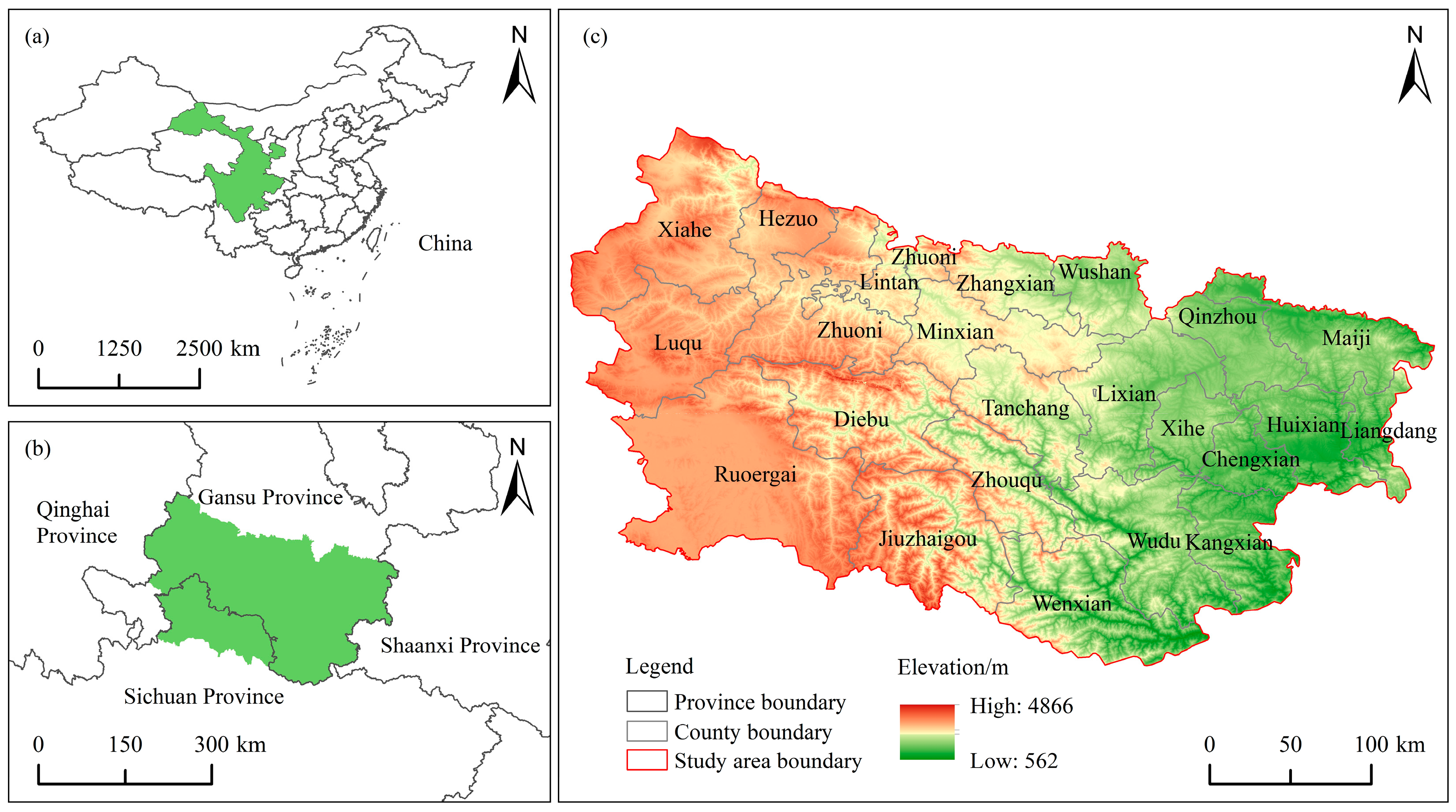
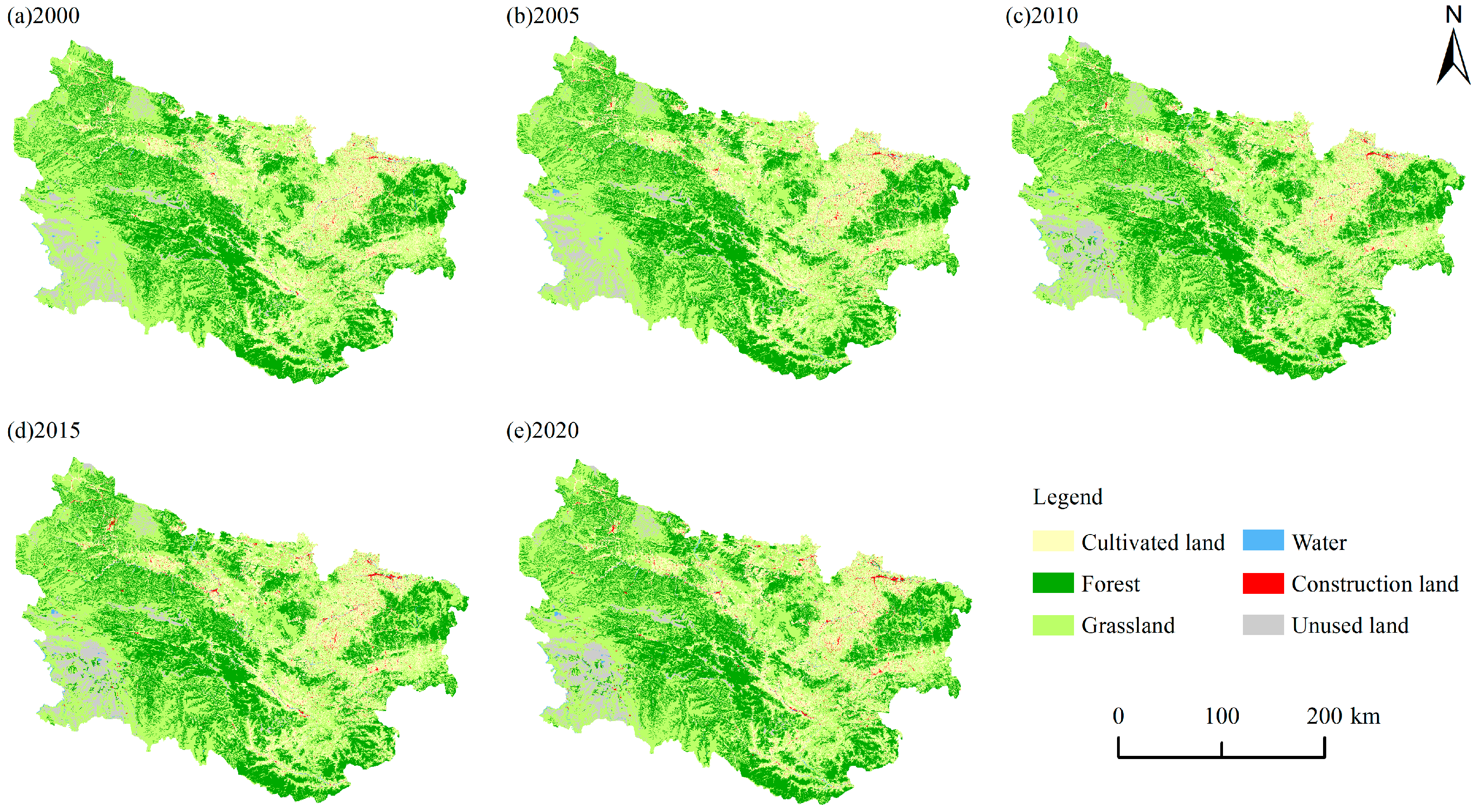



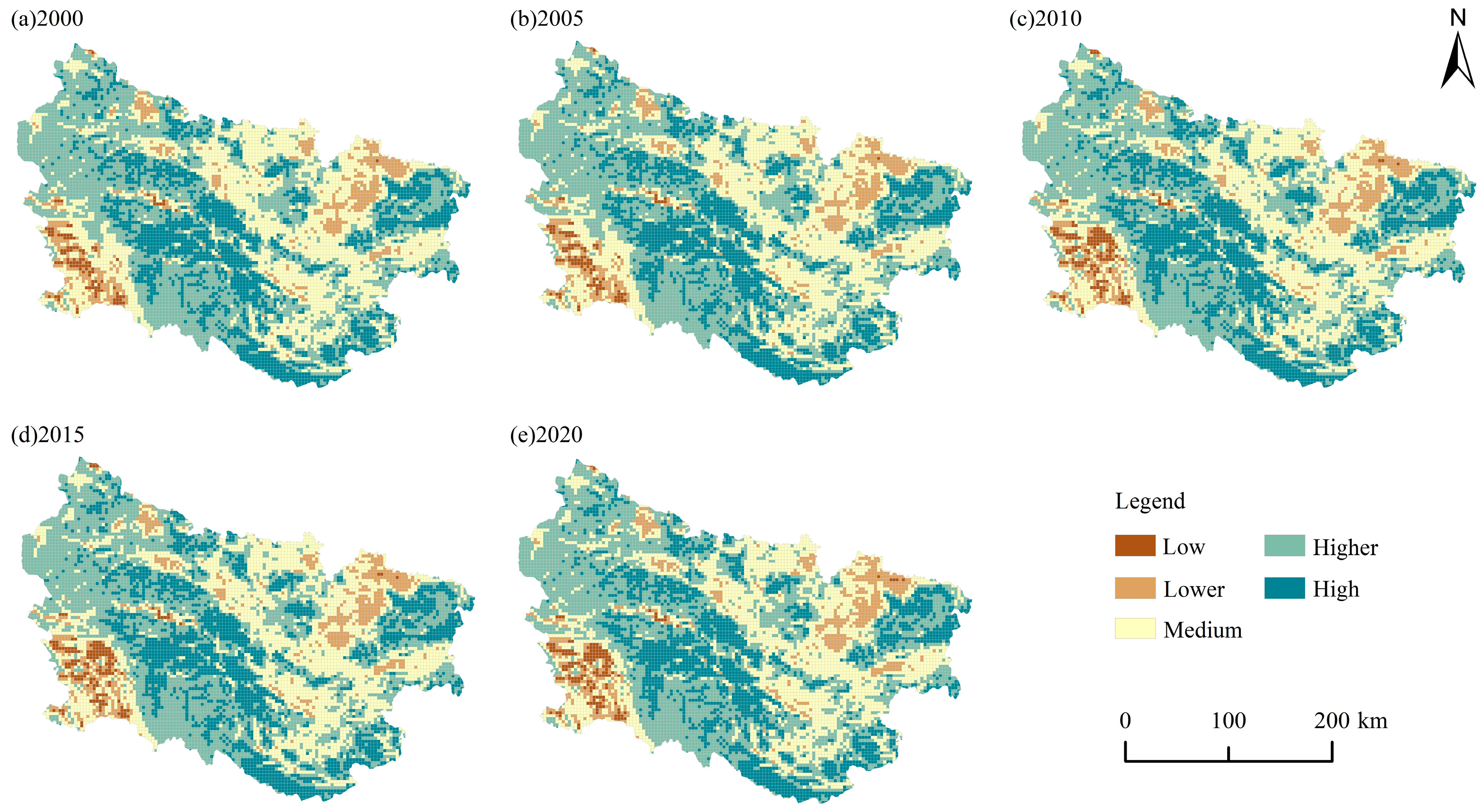

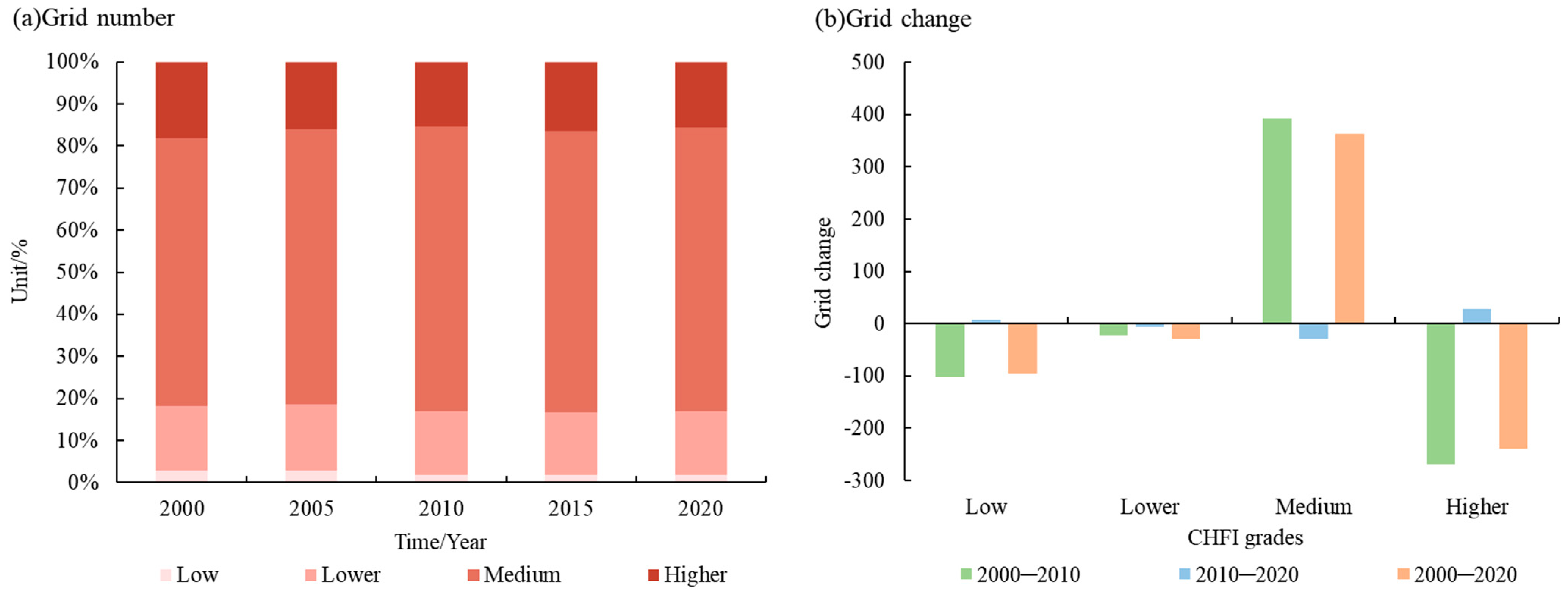
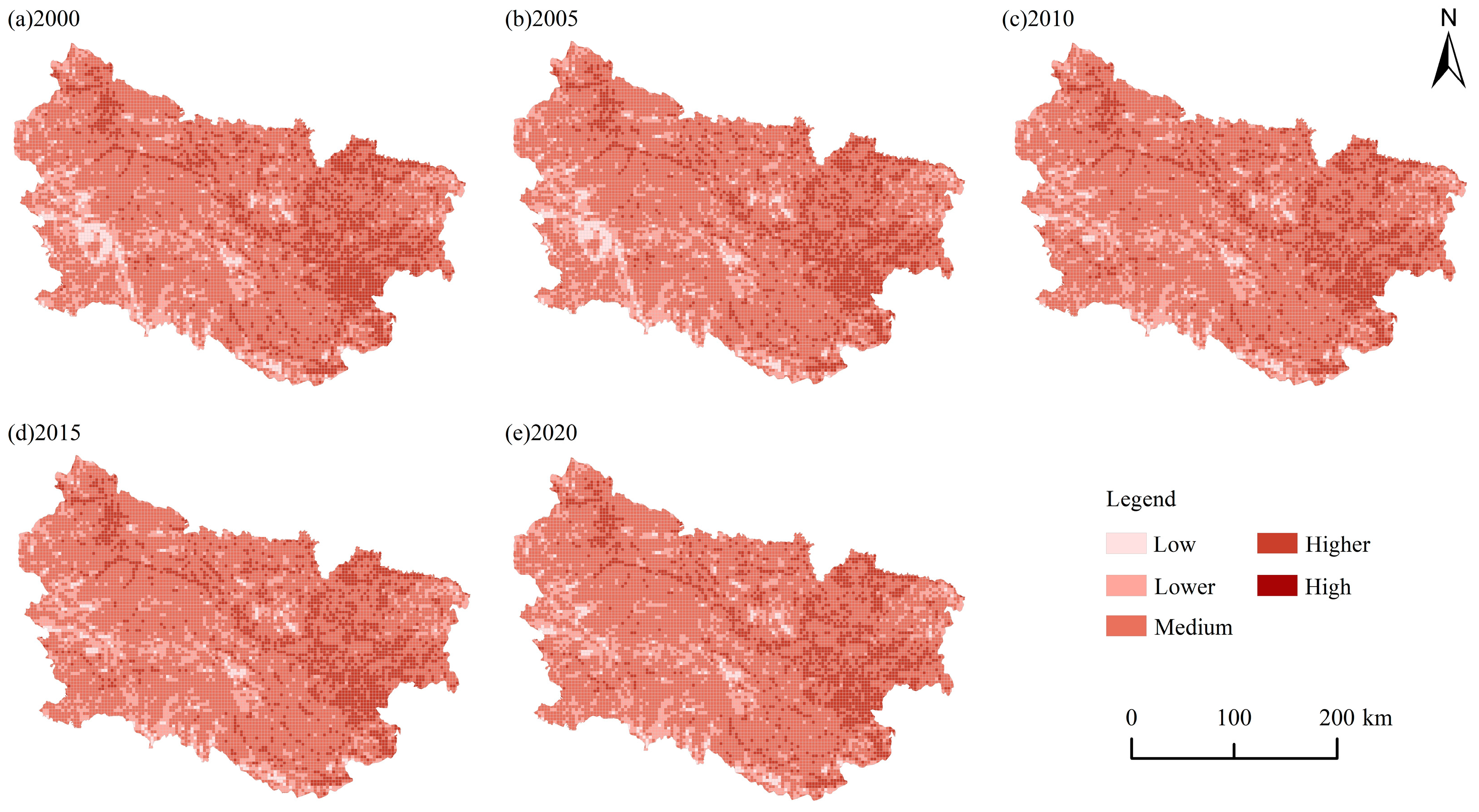
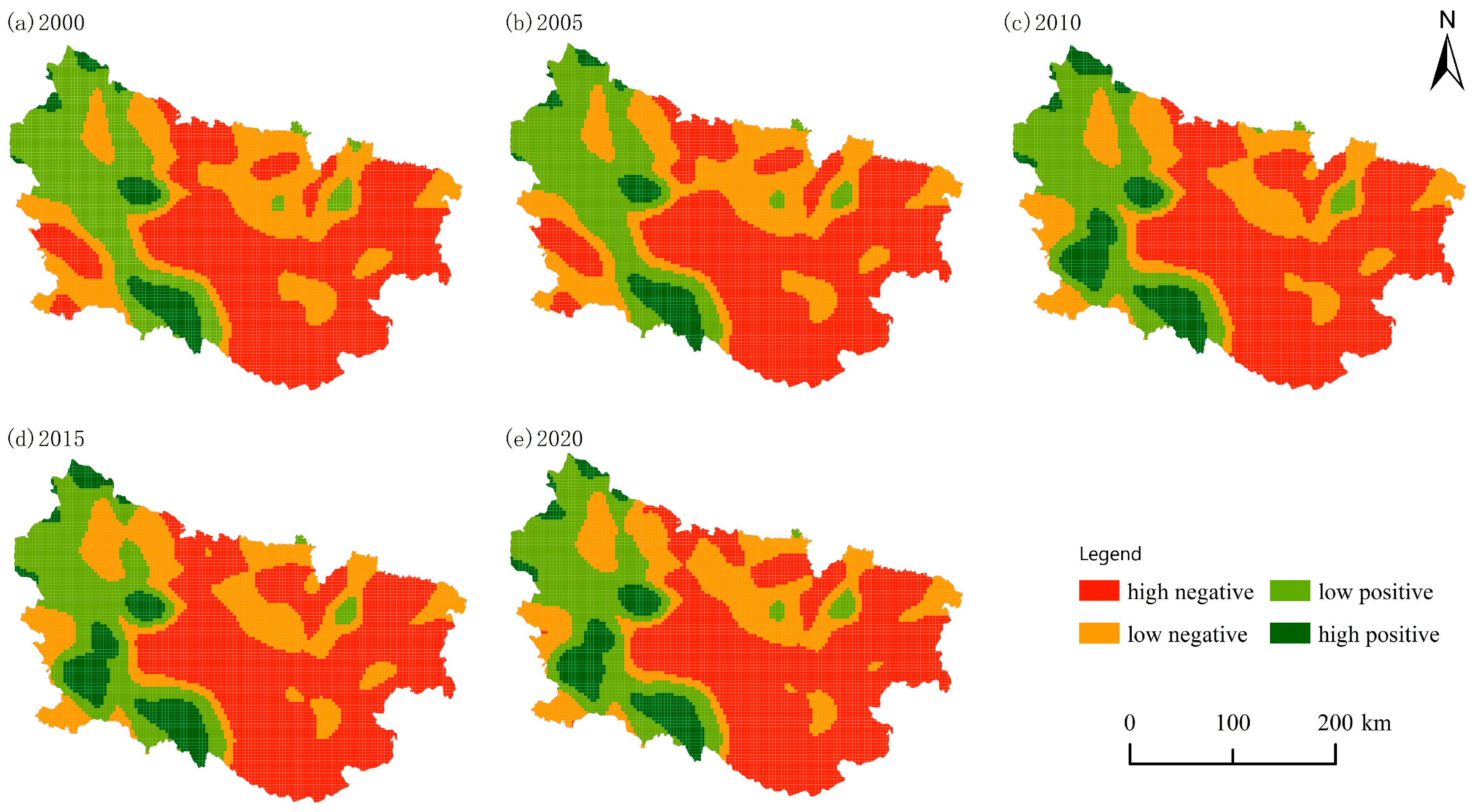
| Threat Factors | Maximum Effective Distance (km) | Weight | Decay Type |
|---|---|---|---|
| Cultivated land | 1.5 | 0.1 | Linear |
| Urban land | 6 | 0.35 | Exponential |
| Rural residential land | 2.5 | 0.2 | Exponential |
| Other construction land | 3 | 0.3 | Exponential |
| Unused land | 2.5 | 0.05 | Linear |
| Habitat Type | Habitat Suitability | Cultivated Land | Urban Land | Rural Residential Land | Other Construction Land | Unused Land |
|---|---|---|---|---|---|---|
| Cultivated land | 0.4 | 0 | 0.5 | 0.35 | 0.4 | 0.4 |
| Forest | 1 | 0.8 | 1 | 0.85 | 0.8 | 0.6 |
| Grassland | 0.6 | 0.5 | 0.6 | 0.4 | 0.5 | 0.6 |
| Water | 0.8 | 0.7 | 0.9 | 0.75 | 0.9 | 0.75 |
| construction land | 0 | 0 | 0 | 0 | 0 | 0 |
| Unused land | 0 | 0 | 0 | 0 | 0 | 0 |
| Landscape Pattern Index | Patch Density (PD) | Mean Patch Area (MPS) | Landscape Shape Index (LSI) | Mean Related Circumscribing Circle (CIRCLE_MN) | Shannon’s Diversity Index (SHDI) | Landscape Division Index (DIVISION) |
|---|---|---|---|---|---|---|
| Patch density (PD) | 1 | |||||
| Mean patch area (MPS) | 0.059 | 1 | ||||
| Landscape shape index (LSI) | −0.022 | 0.584 | 1 | |||
| Mean related circumscribing circle (CIRCLE_MN) | −0.173 | 0.498 | 0.257 | 1 | ||
| Shannon’s diversity index (SHDI) | −0.041 | 0.599 | 0.725 | 0.309 | 1 | |
| Landscape division index (DIVISION) | −0.039 | 0.592 | 0.779 | 0.343 | 0.884 | 1 |
| Type | Features | Landscape Pattern Index | Units | Range | Ecological Significance | VIF |
|---|---|---|---|---|---|---|
| Habitat area | Quantity | Patch density (PD) | Pcs/100 ha | >0 | The greater the PD, the greater the landscape heterogeneity, the greater the degree of fragmentation. | 1.072 |
| Scale | Mean patch area (MPS) | ha | >0 | The greater the MPS, the greater the landscape grain size, the less fragmentation. | 2.112 | |
| Habitat shape | Complexity | Landscape shape index (LSI) | — | ≥1 | The greater the LSI, the more complex the landscape shape, the greater the degree of fragmentation. | 2.766 |
| Compactness | Mean related circumscribing circle (CIRCLE_MN) | — | [0,1] | The greater the CIRCLE_MN, the greater ductile of patch, the greater the degree of fragmentation. | 1.443 | |
| Habitat distribution | Diversity | Shannon’s diversity index (SHDI) | — | ≥0 | The greater the SHDI, the greater the diversity of patch types, the greater the degree of fragmentation. | 4.832 |
| Aggregation | Landscape division index (DIVISION) | % | [0,1] | The greater the DIVISION, the less aggregation of patches, the greater the degree of fragmentation. | 5.749 |
| Year | p Value | AICc | R2 | Adj. R2 |
|---|---|---|---|---|
| 2000 | 0.0000 | −15,078.8848 | 0.6406 | 0.6311 |
| 2005 | 0.0000 | −15,011.7634 | 0.6372 | 0.6276 |
| 2010 | 0.0000 | −14,746.3178 | 0.6509 | 0.6408 |
| 2015 | 0.0000 | −14,768.0726 | 0.6540 | 0.6437 |
| 2020 | 0.0000 | −14,944.5435 | 0.6597 | 0.6491 |
Disclaimer/Publisher’s Note: The statements, opinions and data contained in all publications are solely those of the individual author(s) and contributor(s) and not of MDPI and/or the editor(s). MDPI and/or the editor(s) disclaim responsibility for any injury to people or property resulting from any ideas, methods, instructions or products referred to in the content. |
© 2025 by the authors. Licensee MDPI, Basel, Switzerland. This article is an open access article distributed under the terms and conditions of the Creative Commons Attribution (CC BY) license (https://creativecommons.org/licenses/by/4.0/).
Share and Cite
Hui, C.; Liu, X.; Zhang, X. Exploring the Spatial and Temporal Correlation Between Habitat Quality and Habitat Fragmentation in the West Qinling Mountains, China. Sustainability 2025, 17, 3256. https://doi.org/10.3390/su17073256
Hui C, Liu X, Zhang X. Exploring the Spatial and Temporal Correlation Between Habitat Quality and Habitat Fragmentation in the West Qinling Mountains, China. Sustainability. 2025; 17(7):3256. https://doi.org/10.3390/su17073256
Chicago/Turabian StyleHui, Caihong, Xuelu Liu, and Xiaoning Zhang. 2025. "Exploring the Spatial and Temporal Correlation Between Habitat Quality and Habitat Fragmentation in the West Qinling Mountains, China" Sustainability 17, no. 7: 3256. https://doi.org/10.3390/su17073256
APA StyleHui, C., Liu, X., & Zhang, X. (2025). Exploring the Spatial and Temporal Correlation Between Habitat Quality and Habitat Fragmentation in the West Qinling Mountains, China. Sustainability, 17(7), 3256. https://doi.org/10.3390/su17073256






